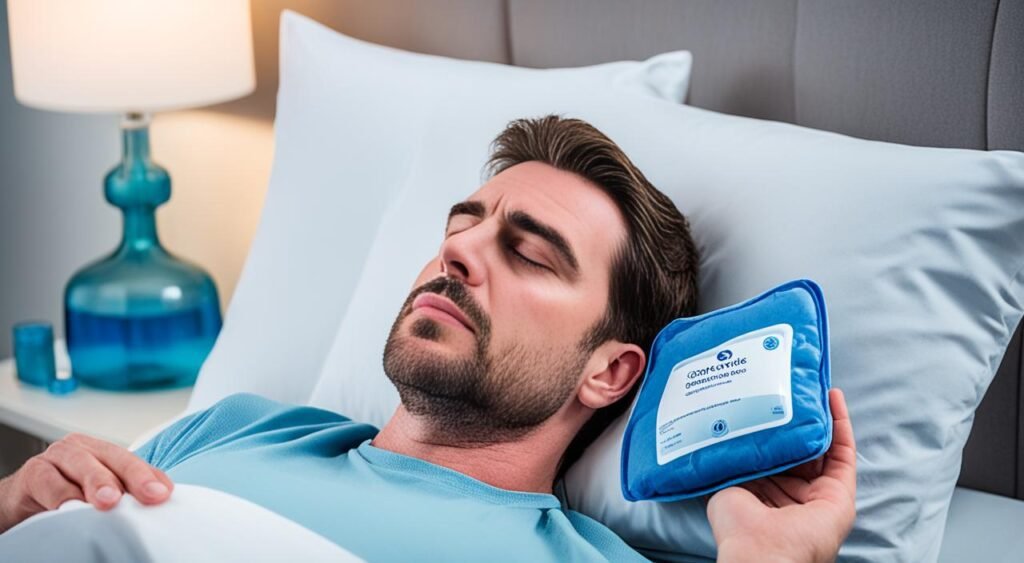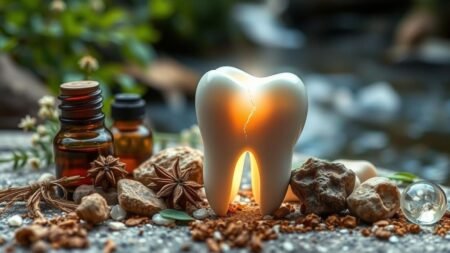Ever wondered why the first night after tooth extraction is tough? Recovering well after tooth removal needs careful attention, especially in the first few hours. The first night after tooth extraction is particularly challenging because your body is working to stop the bleeding and begin the healing process. Let’s explore top recovery tips from Jonathan G. Campbell, DDS, FAGD, a top dentist in Salt Lake City, Utah, to help you navigate this critical time and ensure a smooth recovery.
The hours right after a tooth extraction are key for healing. Doing things right can greatly improve your comfort and recovery. We’ll share expert advice on managing pain, reducing swelling, and keeping your mouth clean. Following these tips can make your recovery smoother.
Did you know your sleep position affects healing? Sleeping with your head raised and using extra pillows helps reduce swelling and boosts blood flow. This can help you sleep better. Also, sticking to rules, like avoiding hard activities, helps with recovery.
Don’t miss out on key advice for easing discomfort and promoting healing. Learn how to make your sleep area better and know when something’s not right. This ensures you’re ready for the first night after your tooth extraction.
The Importance of Proper Rest
Dental experts stress the need for proper rest after a tooth extraction. Getting enough rest helps our body repair and reduce pain. It also prevents complications. The first 24 hours are crucial. In this time, making sure our sleep area is calm and quiet is key.
Experts suggest creating a cozy atmosphere. Using soft blankets and fluffy pillows can help a lot. These items make our head feel supported, which helps reduce swelling and pain.
Keeping our mouth clean after extraction is also vital. Dentists recommend rinsing with warm salt water to keep it clean and promote healing. It’s also wise to avoid sleeping on the side where the tooth was removed for a few nights. Sleeping on the other side helps reduce swelling and makes us more comfortable.
Following these tips is important. Getting a good night’s sleep is crucial for healing. It should be a top priority for a smooth recovery after tooth removal.
Managing Pain and Discomfort
Managing pain after a tooth extraction is key to a quick recovery. Follow the right steps like taking your meds on time, using ice packs, and trying over-the-counter pain relievers. These steps help you heal faster and feel better.
Take Your Pain Medication On Time
One important way to manage pain is to take your meds as directed. Your dentist will tell you how much and when to take them. This keeps the pain under control, especially during the first night when it’s worst.
Setting reminders helps you remember to take your meds. This ensures you don’t miss any doses, keeping the pain away.
Using Ice Packs
Using ice is also crucial. It helps reduce swelling and eases pain. Just put a cold pack on your cheek near the tooth for 10 minutes, then take a break.
Don’t forget to take breaks to avoid skin damage. Using ice in the first 24 hours helps prevent swelling and makes you feel better.
Over-the-Counter Pain Relievers
Over-the-counter pain relievers like ibuprofen or naproxen can also help. These drugs reduce inflammation and ease pain. But, talk to your dentist before taking them with your other meds to make sure they won’t interact badly.
Looking at different ways to handle pain after tooth extraction shows how important a good aftercare plan is. Using meds, ice, and over-the-counter options together helps manage pain well.
| Method | Benefits | Recommendation |
|---|---|---|
| Prescribed Medication | Consistent pain relief | Take on time as per prescription |
| Ice Packs | Reduces swelling, alleviates pain | Apply for 10-minute intervals |
| Over-the-Counter Pain Relievers | Additional inflammation and pain relief | Consult dentist before use |

Optimal Sleeping Position
After a tooth extraction, finding the right way to sleep is key for a smooth recovery. It’s important to keep your head up to lessen swelling and help healing. We’ll share some tips to make sleeping more comfortable and support recovery.
Elevate Your Head
Experts say to keep your head at a 45-degree angle to cut down on swelling. This stops blood from gathering at the tooth extraction spot. Using a recliner or a wedge pillow can help keep your head in the right position.
Use Extra Pillows
Adding more pillows helps keep your head up all night. Place the pillows to support your upper body well. This not only helps with reducing discomfort but also makes sure you sleep well, which is important for healing.
Avoid Sleeping on the Affected Side
Avoid sleeping on the side where the tooth was taken out. This can put too much pressure on the area, causing more pain. Sleep on your back with your head up to help healing and reduce discomfort. Following the best sleeping position after tooth extraction helps you recover faster and more comfortably.
Dietary Guidelines Post-Extraction
After a tooth extraction, following certain dietary guidelines can help heal faster. For the first 24-48 hours, eat soft foods. These foods are easy to chew and swallow, protecting the healing area from strain.
Stick to Soft Foods
Soft foods are key in the early recovery stages. Foods like scrambled eggs, mashed potatoes, yogurt, and smoothies are gentle on the gums. They are easy to swallow and don’t bother the healing tooth area.
- Scrambled eggs
- Mashed potatoes
- Yogurt
- Smoothies
- Blended soups
Avoid Hot or Spicy Foods
Don’t rush back to your usual diet, especially hot or spicy foods. They can irritate the healing area. Such foods can cause pain and slow down healing.

Stay Hydrated Without Straws
Drinking enough water is important for healing, but avoid straws. Straws can dislodge the blood clot, leading to dry socket pain. Drink water or lukewarm beverages instead to stay hydrated safely.
- Drink temperate water regularly
- Opt for lukewarm herbal teas
- Consume hydrating soft foods like soups and smoothies
By eating soft foods and avoiding hot or spicy foods, we help our bodies heal faster and with less pain.
Post-Operative Oral Care
Proper oral care after a tooth extraction is key to healing well and avoiding problems. Start gentle rinsing 48 hours after the surgery. Use a warm saltwater solution to clean your mouth after meals and before bed. This keeps your mouth clean without bothering the healing area.
Be careful when brushing and flossing to not touch the healing area. Using an antibacterial mouthwash is better for oral hygiene at first. Avoid hard swishing that could mess with the blood clot or upset the stitches.
Recovery from a tooth extraction usually takes a few days to two weeks. Dissolvable stitches usually come out in 1-7 days. Non-dissolvable stitches are removed in 7 to 10 days, sometimes up to 3 weeks if needed.
For a clear understanding, here is a table illustrating essential oral care practices post-extraction:
| Oral Care Practice | Description |
|---|---|
| Gentle Rinsing | Start rinsing with warm saltwater 48 hours after surgery, avoiding vigorous swishing to protect the extraction site. |
| Brushing and Flossing | Carefully brush and floss around the extraction site; consider using an antibacterial mouthwash for added protection. |
| Medication Adherence | Follow prescribed medication guidelines, including pain control prescriptions to manage discomfort effectively. |
| Suture Care | Be aware of suture types—dissolvable sutures typically fall out on their own within 10 to 14 days, while non-dissolvable sutures are removed by the dentist in 7 to 10 days. |
| Avoidance Practices | Refrain from rinsing, spitting, or using straws for at least 24 hours to promote clotting and reduce dry socket risk. |
Following these hygiene tips after extraction helps us recover better and keeps our mouths healthy while healing.
Recognizing Signs of Complications
After a tooth extraction, watch for signs that could mean recovery problems. Pain is normal in the first 48 hours and can last up to a week as soreness. But, if the pain gets worse, it could be a sign of trouble.
Swelling is normal and usually gets better within two days. But, if it doesn’t go away or gets worse, it might mean an infection. This is especially true if you notice bad smells or pus.
Keep an eye on jaw stiffness, which can last up to two weeks. If it gets worse or you can’t open your mouth, it could be serious. Also, if teeth next to the extracted one become very sensitive, it’s a sign to see your dentist.
A dry socket, which happens in 5–10% of people, causes a lot of pain and a bad smell. Nerve damage, affecting up to 2% of people, leads to pain, tingling, or numbness. Some people might have temporary nerve problems, but a few could have permanent damage.
Watch for signs of bleeding or unusual drainage. These could mean you’re facing recovery issues that need quick attention. Seeing your dentist early can help prevent complications.
| Complication | Incidence | Symptoms |
|---|---|---|
| Dry Socket | 5-10% | Severe pain, foul smell |
| Nerve Injury | 2% | Pain, tingling, numbness |
| Persistent Swelling | Varies | Increased swelling, pus, unusual odors |
| Persistent Sensitivity | Several weeks | Intense discomfort in adjacent teeth |
| Jaw Stiffness | Up to 2 weeks | Difficulty opening the mouth |
| Persistent Bleeding | Varies | Continuous bleeding from site |
Signs of complications, infections, and recovery issues need quick action to avoid long-term harm. Watching your symptoms and getting help early can make recovery smoother.
What to Do in Case of Bleeding
It’s normal to see some bleeding after a tooth extraction. Managing this bleeding right is key to avoid problems and keep the clot in place. Here are steps to follow if you start bleeding:
Using Gauze Pads
Right after the extraction, put a clean gauze pad over the spot where the tooth was. Bite down gently but firmly to press on it. This helps make a blood clot, which is important for stopping the bleeding and keeping the clot strong. If the bleeding doesn’t stop, change the gauze every 30 minutes.
Applying Gentle Pressure
While using gauze, keep steady pressure by biting down slowly. This gentle pressure helps control the bleeding and keeps the clot in place. But don’t keep taking the gauze out to check the bleeding, as it might disturb the clot. If the bleeding doesn’t stop after an hour or two, you should call a dentist for help.
Avoiding Dry Socket
Avoiding dry socket is key after removing a tooth. This painful condition happens if you don’t take the right steps. By avoiding smoking and rinsing your mouth carefully, you can lower the risk of getting dry socket.
Steer Clear of Smoking and Straws
Smoking is the top cause of dry socket. It’s best to not smoke for at least 5 days after removing a tooth. Smoking can knock loose the blood clot that protects the socket. Even using cannabis or drinking through a straw can be risky.
Studies show smokers are 12% more likely to get dry socket, while non-smokers are only 4% likely. Using nicotine patches is a safer choice during recovery.
Gently Rinse Your Mouth
It’s important to rinse your mouth carefully to prevent dry socket. But, don’t rinse too hard or spit a lot. Instead, use a warm saltwater solution for gentle rinsing.
Be gentle to avoid dislodging the blood clot. Keeping your mouth clean after surgery helps prevent infections and aids healing. Signs of dry socket include a lot of pain, seeing bone in the socket, and bad breath a few days after surgery.
| Activity | Dry Socket Risk |
|---|---|
| Smoking | High (12% for smokers) |
| Using a Straw | Moderate |
| Careful Oral Rinsing | Low |
| Nicotine Patch | Very Low |
Follow these tips and be aware of the risks to lower your chance of getting dry socket after a tooth extraction.
First Night After Tooth Extraction: Key Tips
The first night after a tooth extraction is crucial for a smooth recovery. Following your dentist’s post-operative instructions is key. It’s important to minimize activities and create a serene recovery space. This helps with rest and healing. Here are some tips for your first night post-extraction.
Follow Your Dentist’s Instructions
Your dentist’s instructions are vital for a smooth recovery. They might tell you how to use medication, rinse with warm salt water, and care for the extraction site. It’s important to follow these closely for a better recovery.
Keep Physical Activity to a Minimum
For the first 24 hours, avoid exercise or heavy lifting. This reduces the risk of bleeding and helps healing.
Ensure a Calm and Quiet Environment
Creating a calm recovery space at home is key. Find a quiet room where you can rest without interruptions. This helps with relaxation and pain management.
| Instruction | Details |
|---|---|
| Medication | Follow the prescribed regimen strictly. |
| Physical Activity | Limit exercise and heavy lifting for 24 hours. |
| Rest Environment | Ensure a calm and quiet room for rest. |
Setting Up Your Sleeping Environment
Creating a comfy sleep space is key, especially after a tooth extraction. It helps with sleep improvement and healing. Make sure your bedroom is set up for the best recovery.
One important thing is to keep your head slightly elevated. Use extra pillows for this. It helps reduce swelling and makes sleeping better.
Make your sleeping area quiet and calm. This helps you sleep without interruptions. Good bedding is also crucial. Choose quality pillows and a supportive mattress for better sleep.
Also, keep your room at a comfortable temperature, between 72°F to 76°F. This helps you recover better. A room that’s too hot or cold can disrupt your sleep.
By following these tips, you can make your sleep space better after an extraction. This leads to a more peaceful and healing sleep.
When to Contact Your Dentist
Knowing when to call your dentist after a tooth extraction is key for a smooth recovery. Issues like ongoing pain, signs of infection, and bleeding that won’t stop could mean complications. Let’s look at these scenarios and when to make an emergency contact.
Persistent Pain
If you’re dealing with post-extraction pain that doesn’t go away after a few days, see your dentist. Pain usually gets better after 48-72 hours. If it doesn’t, or if it’s very bad, it could mean a dry socket or another problem.
Signs of Infection
Recognizing infection symptoms early can stop serious health problems. Look out for swelling, pus, fever, and a bad smell or taste in your mouth. These signs mean you might need antibiotics or more dental care.
Continuous Bleeding
Some bleeding after extraction is normal, but it should slow down. If it keeps up and won’t stop with gauze and pressure after 4 hours, it’s a sign. This could mean the blood clot isn’t forming right, and you should call your dentist right away.
Conclusion
The key to a successful tooth extraction recovery is following detailed aftercare steps. It’s important to manage pain well, know what foods to avoid, and keep your mouth clean. These steps, especially in the first night, help reduce pain and avoid problems.
Following advice on rest and activity helps reduce risks and aid healing. It’s crucial to watch for signs like ongoing pain or too much bleeding. If you see these, you might need to call a dentist.
Using these healing insights helps you recover faster and keeps your mouth healthy for the long term. The first 24 hours are very important. Doing things like sleeping with your head raised and not smoking or using straws helps keep the blood clot at the extraction site safe. Our aftercare summary shows how important a careful approach is during this time. It helps you get back to normal faster.
FAQ
What are some effective recovery tips for the first night after tooth extraction?
Follow your dentist’s advice on pain meds and sleep. Use a special pillow to keep swelling down. Stick to the diet and oral care plan given to you.
Why is rest important after a tooth extraction?
Rest helps your body heal and reduces pain. A quiet sleep area boosts your recovery. It’s key for a smooth recovery the first night after.
How can I manage pain and discomfort effectively after a tooth extraction?
Take your pain meds as told. Use ice packs to lessen swelling. If okayed by your dentist, try over-the-counter pain relievers like ibuprofen.
What is the best sleeping position to reduce discomfort after a tooth extraction?
Use extra pillows to lift your head. Avoid sleeping on the side where the tooth was taken out. This helps prevent extra pressure and irritation.
What foods should I eat after a tooth extraction?
Eat soft foods like yogurt and smoothies. Stay away from hot or spicy foods that can bother the area. Drink plenty of water but avoid straws to prevent dry socket.
How should I care for my mouth post-extraction?
Rinse with warm saltwater after meals and before bed. Use an antibacterial mouthwash to keep your mouth clean. Be gentle around the extraction site.
What are the signs of complications after a tooth extraction?
Watch for too much pain, swelling, bad smells, or bleeding that won’t stop. If you see these, see your dentist right away.
How should I handle bleeding after a tooth extraction?
Apply gentle pressure with clean gauze to the area to help it clot. If bleeding won’t stop, you need to see your dentist quickly.
What precautions can help prevent dry socket?
Avoid smoking and straws to keep the blood clot in place. Use warm saltwater for gentle rinses instead.
What are the key tips to follow the first night after tooth extraction?
Listen to your dentist’s advice closely. Don’t overdo it physically. Make sure your sleeping area is calm and quiet to help healing.
How can I create a comfortable sleeping environment after a tooth extraction?
Use extra pillows to lift your head. Make sure your sleeping area is quiet and comfy. This helps you sleep better and recover faster.
When should I contact my dentist post-extraction?
Call your dentist if you have ongoing pain, swelling, bad smells, or bleeding that won’t stop with pressure.








